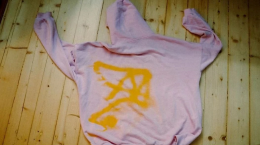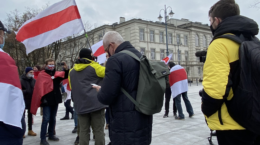Recently, the Belarusian regime permitted a rare visitation between Belarusian political prisoner Maria Kalesnikava and her father. Maria, one of the leaders of the 2020 Belarusian revolution, is currently serving an 11-year sentence. Maria was in incommunicado mode for more than 600 days.
The second leader of the Belarusan revolution Veronika Tsepkalo received 12 years in absentia prison within the framework of one criminal case on “attempted coup d’état”. Veronika Tsepkalo’s accomplice in this criminal case, human rights defender Olga Karach, was also awarded 12 years in prison and 170,000 euros in fines.
In a photo from the visitation of Maria with her father, a prominent yellow badge can be seen on Kalesnikava’s prison uniform. This badge symbolizes the Belarusian authorities’ use of color-based stigmatization of prisoners, a disturbing practice first exposed by the human rights organization Our House.

In Belarus, prison authorities mark political prisoners with yellow badges, evoking painful historical memories of Holocaust stigmatization, when yellow stars were used to single out Jews in Nazi concentration camps. Through this system, yellow badges now identify and isolate political prisoners, allowing for additional repression and stringent monitoring within the prison system. While Belarus’ Ministry of Internal Affairs initially denied using such stigmatization tactics and even tried to charge “Our House” with libel., they eventually conceded under the pressure of irrefutable evidence from Our House defenders, acknowledging the use of various badge colors to denote different categories of prisoners.
Since 2018, Our House has consistently documented and protested the inhumane color-based classification system in Belarusian prisons. This practice initially gained attention through the Our House’s advocacy campaign “Children-328,” which sought to expose and combat the wrongful detention of children as young as 14 under Article 328. Many of these children, often victims of fabricated small non-violent drug-related charges, are sentenced to lengthy prison terms, sometimes as severe as 8–10 years. Children imprisoned under Article 328 are forced to wear green badges, which mark them as targets for increased restrictions, limited family contact, and frequent cell inspections.
Beyond coloring prisoners, Belarusian authorities employed colors for labeling protestors during the arrests and detentions of the 2020 Belarusian protests. Different colors indicated the intensity of abuse or torture that detainees could expect, both in detention centers and police stations.
The stigma of the yellow badge for political prisoners is one of the clearest symbols of the state’s attempt to dehumanize and isolate political prisoners in Belarus. Our House condemns this misuse of Holocaust symbols to enforce oppression and stigmatization and continues to call for international attention and action against these inhumane practices.
A full report and analysis on color-based stigmatization in Belarusian prisons, as documented by Our House, is available for those seeking further insight into these repressive practices.












